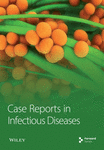Two Cases of Maggot-Associated Ignatzschineria Bacteremia in Xylazine-Induced Injection Wounds: An Emerging Threat
Abstract
The city of Philadelphia has seen an increase in homelessness and substance use disorders, often associated with xylazine-contaminated opiates. Here, we report the first two cases of wound infection and bacteremia associated with the Gram-negative rod Ignatzschineria species. Both cases were associated with maggot colonization in chronic lower extremity wounds from fentanyl/xylazine injections. Poor living conditions and lack of wound care are central to both case presentations. We believe this organism to be an emerging medical threat associated with injection drug use, xylazine-associated wounds, and homelessness which may impact future treatment options in this patient population. This report underscores the emergence of Ignatzschineria bacteremia in individuals with a history of xylazine-associated wounds and substance use disorder. Successful management should prioritize wound care and adherence to antibiotic regimens to prevent complications in these challenging cases.
1. Introduction
The ongoing opioid epidemic continues to inflict deleterious consequences on patients with opiate use disorder. After the rise of fentanyl, a substance known as xylazine (tranq) is often incorporated into the supply to enhance sedative effects. Xylazine is an alpha-2-adrenergic agonist commonly used as a veterinary anesthetic and sedative [1]. Although not approved for human use, xylazine is causing detrimental health concerns in persons who inject drugs (PWID) including overdose and wound-related infection. The exact mechanism for xylazine-induced skin injury is unclear, but it has been thought to be due to peripheral vasoconstriction leading to vascular damage. Other postulated causes of skin injury include cytotoxic effects, high frequency of injection, pressure injury from prolonged sedation, and small vessel vasculopathy. Although human studies are limited, animal models have shown xylazine to be responsible for decreased tissue oxygen perfusion, which can contribute to poor wound healing [2]. These wounds can occur at injection sites and noninjection sites of the skin. Wound-related infection is common due to poor living conditions, minimal access to healthcare, and inadequate hygiene [3–5].
Here, we report two separate cases of atypical bacteremia caused by the Gram-negative rod Ignatzschineria species from maggot-infested xylazine wounds during the summer season in Philadelphia, PA. To our knowledge, this is the first report of Ignatzschineria bacteremia in patients with myiasis of xylazine wounds. Given the current status of the opioid epidemic, we believe that Ignatzschineria is an emerging threat to populations with high rates of both homelessness and use of xylazine-containing substances. The Philadelphia Department of Public Health documented 1413 unintentional overdose deaths in 2022, indicating an increasing trend compared to previous years, with 34% of these overdose fatalities linked to xylazine involved in the use of fentanyl [5]. Philadelphia, in particular, faces challenges including alternate drug supply, significant injuries resulting from xylazine use, stimulant-related overdoses, overdoses among individuals not identifying as substance users, and the widespread impact of this crisis throughout the city, particularly affecting communities of color [5]. Additionally, xylazine also suppresses respiration which makes overdose reversals more difficult [5]. Various cases of xylazine wound-related bacteremia have been previously reported in Philadelphia with typical causative organisms including Staphylococcus and Streptococcus. Ignatzschineria bacteremia has been reported previously but never in association with wounds from xylazine.
2. Case Presentations
2.1. Case 1
A 38-year-old female with injection drug use, hepatitis C, HIV, and bipolar disorder, presented with a right leg wound infested with maggots. Her right lower extremity showed an ulcerated, eschar-appearing wound surrounded by erythema and induration that was tender to palpation (Figure 1). The patient reported intravenous use of 2.5 bundles (approximately 30 bags) of fentanyl/xylazine and 3 bars (6 mg) of alprazolam daily. The patient has used substances for 9 years and maintained her addiction through sex work. She reports homelessness with safety, food, and financial insecurities. Labs revealed a normal WBC count (7.1 k/μL) and elevated CRP (34.0 mg/L). CT of the lower right extremity showed cutaneous and subcutaneous ulcerations with localized pockets of soft tissue gas deep to the ulceration, diffuse cellulitis, and an abscess in the subcutaneous soft tissue of the dorsal foot at the level of the second and third metatarsal bases. She was managed with local wound care, bedside debridement, and antibiotic therapy with vancomycin and piperacillin/tazobactam. Prior to susceptibility result, she self-discharged on hospital day 3, with prescriptions for doxycycline and amoxicillin/clavulanic acid. Blood cultures later grew Ignatzschineria ureiclastica, susceptible to piperacillin/tazobactam, cefepime, ceftazidime, meropenem, aztreonam, ciprofloxacin, gentamicin, and trimethoprim/sulfamethoxazole. The patient returned 1 month later but left again after 5 days. Two weeks later, she returned with the same complaint and received 10 days of amoxicillin/clavulanic acid and trimethoprim/sulfamethoxazole. She declined inpatient drug rehab and was ultimately lost to follow-up.
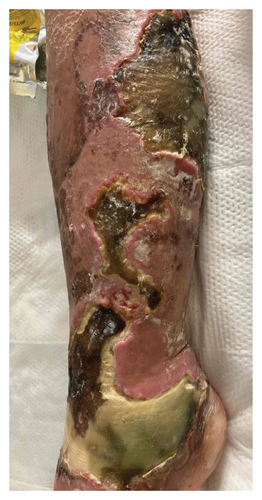
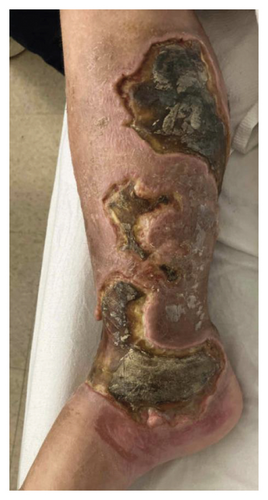
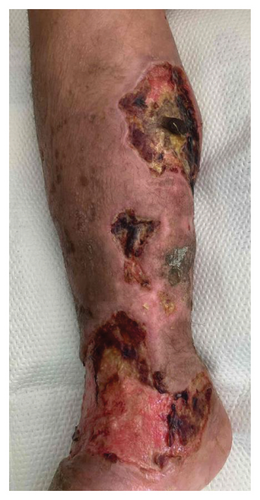
2.2. Case 2
The second case is a 46-year-old male with injection drug use who presented with maggot infestation and drainage of his wounds. He currently injects into his legs, but previously “skin popped” into his neck. He reported using 1-2 bundles of fentanyl (approximately 20 bags) daily and has been using opioids for 20 years. He is homeless and dwells in the community, lacking social support. Last hospitalization was 1 month prior for cellulitis, myositis and osteomyelitis of the lower extremities, accompanied by maggot infestation, treated with vancomycin and cefepime. Blood cultures during that admission revealed Wohlfahrtiimonas chitiniclastica, a gram-negative bacillus found in the larva of Wohlfahrtia magnifica. He returned due to progressive lower extremity pain. On physical examination, the patient had generalized leg pain with maggots in bilateral leg wounds and dark-colored discharge from his left leg (Figure 2). Labs revealed a WBC count of 10 K/μL. CT confirmed cellulitis with soft tissue defects along the anteromedial aspect of the lower legs, and pockets of entrapped superficial soft tissue gas, in addition to bilateral tibial osteomyelitis, and prominent inguinal and femoral lymphadenopathy. He was empirically started on daptomycin and cefepime. Dakin’s Solution was applied to cleanse the wound. Blood cultures grew Moraxella species, Ignatzschineria larvae and Alkaliphilus oremlandii. Ignatzschineria was susceptible to piperacillin/tazobactam, cefepime, ceftazidime, meropenem, aztreonam, ciprofloxacin, gentamicin, and trimethoprim/sulfamethoxazole. Alkaliphilus oremlandii was susceptible to penicillin, piperacillin/tazobactam, ertapenem, clindamycin, and metronidazole. On day 3 of admission, all maggots were removed, necrotic tissues were debrided at bedside and his wound was dressed with Dakin’s Solution soak. The patient reported improved lower extremity pain the following day. He subsequently eloped from the hospital without any prescriptions, but returned to the hospital 2 months later after bystanders found him unconscious. During that admission, his wounds were infested with maggots again and he had Pasteurella bacteremia. Ultimately, he left the hospital again prior to completion of treatment and was lost to follow-up.
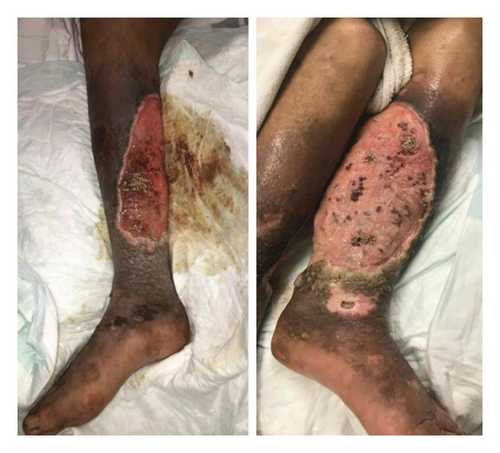

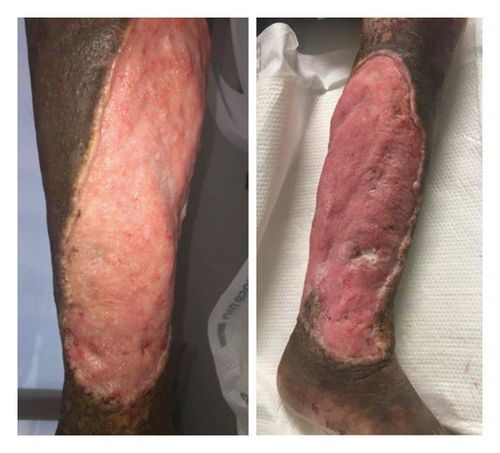
3. Discussion
The Ignatzschineria genus is a gram-negative bacterium that is nonmotile, nonsporulating, nonhemolytic, and rod-shaped [6]. The species belonging to this genus are: Ignatzschineria indica, I. ureiclastica, and I. larvae, first isolated from the intestinal tract of Wohlfahrtia magnifica larvae [7]. This case report presents two different patients of Ignatzschineria bacteremia associated with myiasis in Philadelphia, Pennsylvania within 2 months during the summer season. Both cases can be attributed to poor living conditions, ongoing intravenous drug use, and chronic xylazine-associated wounds. While myiasis infections are mostly documented in tropical and subtropical environments, strong social risk factors predispose patients to Ignatzschineria infections even in urban settings. These cases are particularly challenging given the extent of xylazine wounds. As illustrated in Figures 1 and 2, xylazine-associated wounds are profoundly advanced and require intensive wound care. In addition to Ignatzschineria, other uncommon organisms hosted by the larvae of Wohlfahrtia magnifica such as Wohlfahrtiimonas may be seen on cultures.
Other cases of Ignatzschineria bacteremia have rarely been reported. The first reported case of Ignatzschineria bacteremia occurred in 2014 [7]. To our knowledge, there are a total of 17 other reports in the literature (summarized in Table 1) [7–24]. All these cases described patients with chronic wound myiasis and none are associated with injection drug use or xylazine. Only one case resulted in death, however, there was “no evident cause” reported [8]. Compared to other reported cases of Igantzschineria bacteremia, typical wounds associated with diabetes, peripheral vascular disease and other conditions compromise the vascular supply and the inflammatory response, which make these individuals more susceptible to skin infections. Drawing parallel to those conditions, wounds from recurrent xylazine exposure may share a similar mechanism of reduction of blood supply and damage to small vessels, leading to diminished oxygen delivery and causing soft tissue infections and delayed healing process. Necrotic tissues attract parasitic fly for which larvae can feed on, leading to maggot infestation, exposing the human host to Ignatzschineria [25]. This was further exacerbated by social factors and environmental factors, such as hot summer temperature.
| Author | Year | Location | Blood cultures | Relevant information | Treatment | Outcome |
|---|---|---|---|---|---|---|
| Barker et al. [6] | 2014 | United States | Ignatzschineria indica | Homelessness, chronic left foot wound | Wound debridement, left third toe amputation, empiric ampicillin-sulbactam/vancomycin narrowed to cephalexin | Lost to follow up |
| 2014 | United States |
|
Chronic alcohol use, chronic left heel ulcer wound | Left leg amputation, empirici piperacillin-tazobactam/clindamycin narrowed to vancomycin/ciprofloxacin | ||
| 2014 | United States | Ignatzschineria indica | Paraplegic, poor hygiene, chronic decubitus ulcers | |||
| Le Brun et al. [7] | 2015 | France |
|
Cardiac arrest, necrotic wound of right shoulder, maggots around genitalia | ICU admission (had cardiorespiratory arrest), empiric ceftriaxone | Expired |
| Heddema, Janssen, and van Westreenen [8] | 2016 | Netherlands | Ignatzschineria spp. | Chronic alcohol use, right foot wounds, loss of consciousness | ICU admission for noninvasive ventilation, amoxicillin-clavulanic acid | Discharged |
| Cipolla et al. [10] | 2017 | Argentina | Ignatzschineria indica | Homelessness, chronic alcohol use, necrotic ulcer of the left lower extremity | Debridement, left leg amputation, ciprofloxacin/clindamycin | Discharged |
| Muse et al. [11] | 2017 | United States |
|
Cardiac arrest, bedbound status, sacral decubitus ulcer, left heel ulcer, laceration of the back | ICU admission requiring vasopressors, mechanical ventilation. Wound debridement. Empiric vancomycin, cefepime and metronidazole, narrowed to levofloxacin | Discharged |
| Rodríguez-Zúñiga et al. [12] | 2018 | Spain | Ignatzschineria indica | Chronic alcohol use, wounds on right lower leg and left foot | Amoxicillin-clavulanic acid | Discharged |
| Nadrah et al. [13] | 2019 | Slovenia |
|
Irregular migrant, poor hygiene, diffuse bilateral superficial wounds on thighs and legs | Serial wound debridement, empiric flucloxacillin/ciprofloxacin, then imipenem/cilastatin/vancomycin | Discharged to detention center. Unable to follow up |
| Grasland et al. [14] | 2019 | France | Ignatzschineria larvae | Ceftriaxone/gentamicin narrowed to amoxicillin-clavulanic acid | ||
| Deslandes et al. [15] | 2019 | Canada | Ignatzschineria indica | Poor hygiene, diabetes, chronic left leg wound | Empiric piperacillin-tazobactam, narrowed to amoxicillin/clavulanic acid | Discharged |
| Lysaght et al. [16] | 2020 | United States |
|
Chronic lymphedema, left foot, and leg ulcers | Debridement, empiric vancomycin, clindamycin and piperacillin-tazobactam, narrowed to cefepime | Discharged |
| Snyder, Singh, and Goldman [17] | 2020 | United States |
|
Poor hygiene, peripheral vascular disease, chronic bilateral leg wound | Empiric vancomycin/cefepime, switched to daptomycin/ceftriaxone | Discharged |
| Berthod et al. [18] | 2020 | Switzerland | Ignatzschineria larvae | Amoxicillin/clavulanic acid, transitioned to trimethoprim/sulfamethoxazole | ||
| Fear et al. [19] | 2020 | Canada | Ignatzschineria indica | Homelessness, diabetes, gangrenous wound of the left leg | Empiric piperacillin-tazobactam narrowed to amoxicillin-clavulanate | Discharged |
| Do et al. [20] | 2021 | United States |
|
Poor hygiene, chronic wound on anterior left ankle | Irrigation and debridement. Empiric vancomycin, cefepime, changed to piperacillin-tazobactam | Discharged |
| Maniam and Argentine [21] | 2021 | United States | Ignatzschineria spp. | Opioid use disorder, peripheral vascular disease, poor hygiene, chronic left foot wound | Empiric vancomycin/cefepime, narrowed to levofloxacin | Discharged |
| Reed, Reynolds, and Smith [22] | 2021 | United States |
|
Opioid use disorder, cocaine use disorder, self-neglect, left leg wound | Piperacillin-tazobactam and then meropenem | Incomplete treatment, lost to follow-up |
| DiFranza et al. [23] | 2021 | United States |
|
Opioid used disorder, chronic alcohol use, poor hygiene, chronic venous stasis with left leg ulcerated wound | Tazobactam/vancomycin, narrowed to levofloxacin/doxycycline | Discharged |
| Demurtas, Pareti, and Madanchi [24] | 2023 | Switzerland | Ignatzschineria larvae | Poor hygiene, peripheral vascular disease, chronic bilateral leg ulcers | Wound debridement, ertapenem, narrowed to trimethoprim/sulfamethoxazole | Discharged |
Poor living conditions can lead to significant barriers in accessing medical care such as lack of transportation, inability to pay for medical care, and competing priorities such as finding food and shelter. Addressing the challenges in treating these presentations of wounds, especially those infected with uncommon organisms, requires medical interventions in addition to a comprehensive approach considering the patients’ psychosocial factors that are critical in determining treatment and care. For patients that choose to leave the hospital, managing the treatment of their infections becomes more challenging. Physicians must balance the patient’s health with incomplete work-up, adherence to therapy, and antimicrobial resistance.
Implementing preventative measures and providing trauma-informed care to patients can prevent limb complications and recurrent bacteremia cases. Particularly in patients who are already presenting with severe extremity wounds, emphasis should be placed on seeking early treatment to prevent advanced wound degradation processes. In addition, counseling and resources related to addiction recovery should be provided with each encounter.
4. Conclusion
In summary, Ignatzschineria bacteremia in PWID should be considered as an emerging threat as maggot infestations of wounds become more common. Careful consideration should be emphasized on proper wound care and adherence to antibiotic regimens to prevent further complications arising from these wounds. Moreover, prevention and trauma-informed care are essential to reducing potential complications associated with wound infections. This is the first report of Ignatzschineria bacteremia in patients with myiasis of xylazine wounds. These cases underscore the importance of both proficient wound recuperation techniques and strict adherence to antibiotic therapy.
Conflicts of Interest
The authors declare no conflicts of interest.
Author Contributions
Erin Pomerantz and Olivia Pericak wrote the manuscript jointly. Carly Sokach, Jocelyn Edathil, and Ho-Man Yeung contributed to the design and conception of the case report. All authors reviewed and approved the submitted manuscript. Erin Pomerantz and Olivia Pericak made equal contribution to this study.
Funding
Publication of this article was funded in part by the Temple University Libraries Open Access Publishing Fund.
Acknowledgments
The authors have nothing to report.
Open Research
Data Availability Statement
Data are available upon request to corresponding author.



